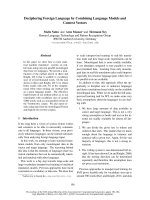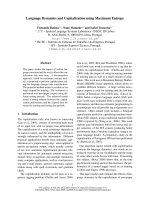Language barriers and hospital readmissions rates
Bạn đang xem bản rút gọn của tài liệu. Xem và tải ngay bản đầy đủ của tài liệu tại đây (253.57 KB, 8 trang )
Language Barriers and Hospital
Readmission Rates: An Overview
Introduction: The Cost Implications of Hospital
Readmissions
Each year, approximately 2 million Medicare beneficiaries are readmitted to the hospital
within 30 days of discharge, costing the federal health insurance program $26 billion.1 Of this
figure, an estimated $17 billion results from potentially avoidable readmissions.2
Preventing needless hospital readmissions has
become a major target of cost control for
healthcare providers in recent years—an
objective due in no small part to the Hospital
Readmissions Reduction Program (HRRP).
Established under Section 3025 of the
Affordable Care Act, the HRRP penalizes
hospitals with Medicare readmission rates that
exceed national averages.3 In short, the HRRP
aims is to cut excessive healthcare spending
while improving patient safety and quality of care.4
Am. Hosp. Ass’n, Examining the Drivers of Readmissions and Reducing Unnecessary Readmissions for Better
Patient Care, Trend Watch (Sep. 2011), />Joseph R. Betancourt et al., Ctrs. for Medicare & Medicaid Servs., Guide to Preventing Readmissions among
Racially
and
Ethnically
Diverse
Medicare
Beneficiaries
1
(2015),
available
at
/>1
2
Betancourt et al., Guide to Preventing Readmissions, supra, at 2.
Pub. L. No. 111–148 § 3025(a), 124 Stat. 119, 408 (2010). See also Ctrs. for Medicare & Medicaid Servs.,
Readmissions Reduction Program (HRRP),
/>for Fewer Hospital U-turns: The Medicare Hospital Readmission Reduction Program: Issues Brief (Mar. 10, 2017),
/>tion-program.
3
4
Am. Hosp. Ass’n, Examining the Drivers of Readmissions, supra.
1
While not all readmissions are preventable, hospitals can preempt a number of them by
addressing certain barriers patients face before, during, and after admission and discharge.5
Several studies have shown that demographic and socioeconomic factors—such as a
patient’s race, ethnicity, language proficiency, age, socioeconomic status, place of residence,
and disability—may be predictors of readmission risk.6 Given today’s increasingly diverse
patient population, these factors present a daunting challenge for hospitals delivering
high-quality care while addressing the persistent cost implications of readmissions.
The Effect of Language Barriers
Approximately 64.7 million individuals—both foreign and native born—speak a language
other than English at home, according to the U.S. Census Bureau.7 While the majority of these
individuals also speak English either fluently or very well, nearly 40 percent (25.9 million) are
considered Limited English Proficient (LEP).8 Limited English proficiency refers to anyone
above the age of 5 who reported speaking English less than “very well,” as classified by the
Census Bureau.9
In a 2006 survey, 63% of hospitals nationwide
reported encountering LEP patients either
daily or weekly.10 Moreover, the LEP
population accounts for approximately 4
million or 8% of the more than 52 million
Medicare beneficiaries, raising significant cost
5
Betancourt et al., Guide to Preventing Readmissions, supra, at 1.
6
Id. (citing various studies for each of these factors); see also Am. Hosp. Ass’n, Examining the Drivers of
Readmissions and Reducing Unnecessary Readmissions for Better Patient Care, Trend Watch (Sep. 2011) (same).
Migration Policy Instit., Language Diversity and English Proficiency in the United States (Nov. 11, 2016) (citing
U.S. Census Bureau, American Community Survey Data),
/>7
8
Id.
9
Id.
Romana Hasnain-Wynia et al., Hospital Language Services for Patients with Limited English Proficiency:
Results from a National Survey i (2006), available at
/>10
2
implications for hospitals that ignore the potential impact language barriers have on
readmissions.11 According to the Centers for Medicare and Medicaid Services, “Limited
English proficiency is associated with several factors that contribute to avoidable
readmissions, including lower rates of outpatient follow up and use of preventive services,
medication adherence, and understanding discharge diagnosis and instructions.”12 Research
has also shown that language barriers—reinforced by the absence of a qualified
interpreter—often result in extended hospital stays.13 Several peer-reviewed, physician-led
studies affirm these general observations. Specific findings include the following:
● The length of stay for LEP patients with certain medical and surgical conditions is
approximately 0.5 days longer than English-proficient (EP) patients with similar
conditions.14
● The length of stay for LEP patients without access to an interpreter on both
admission and discharge days is about 1.5 days longer than LEP patients with access
to interpreters on both days.15
● Readmission rates for LEP patients without access to an interpreter on both
admission and discharge days are 9.4% higher than LEP patients with access to
interpreters on both days.16
Ctrs. for Medicaid & Medicare Servs., Off. of Minority Health, Understanding Communication and Language
Needs of Medicare Beneficiaries (2017).
11
Joseph R. Betancourt et al., Ctrs. for Medicare & Medicaid Servs., Guide to Preventing Readmissions among
Racially
and
Ethnically
Diverse
Medicare
Beneficiaries
5
(2015),
available
at
See
also Joseph R. Betancourt et al., Agency for Healthcare Research and Quality, Improving Patient Safety Systems
for Patients With Limited English Proficiency: A Guide for Hospitals 3 (2012).
12
Leah S. Karliner et al., Language Barriers and Understanding of Hospital Discharge Instructions, 50 Med. Care
283 (Apr. 2012), available at Mary Lindholm et al.,
Professional Language Interpretation and Inpatient Length of Stay and Readmission Rates, 27 J. Gen. Intern. Med.
1294 (Apr. 2012), available at />13
A. John-Baptiste et al., The Effect of English Language Proficiency on Length of Stay and In-Hospital Mortality, 19
J. Gen. Internal Med. 221 (2004).
14
15
Lindholm et al., Professional Language Interpretation, supra, at 1296.
16
Id. at 1297.
3
● A 2017 study reported a 4.4% decrease in hospital readmission rates among LEP
patients with 24-hour access to remote (phone) interpreter services during an
8-month period, resulting in an estimated total savings of $1.3 million after
accounting for interpreter service costs.17
● Non-professional, ad hoc interpreters—who may include family members, friends,
nonclinical hospital employees, or others with no formal training—can misinterpret
or omit up to half of physicians’ questions, are less likely to note medication side
effects or other information of clinical significance, and have a higher risk of ignoring
embarrassing issues (especially when children or other family members are used to
interpret).18
● LEP patients are 40% more likely than EP patients to experience physical harm
associated with an adverse event, a result due in large part to communication errors.19
Recommendations
Effective communication is essential for providing quality care to LEP patients. The following
measures, when combined with other strategies, are likely to reduce readmission rates and
hospital stays among the LEP patient population:
● Confirm that LEP patients are aware of, and have access to, a qualified medical
interpreter during inpatient stays, discharge, and when accessing post-hospital care.
● Ensure that discharge instructions, both oral and written, are communicated in the
patient’s preferred language.
● Avoid using a patient’s family members or friends as interpreters. These persons may
Leah S. Karliner et al., Convenient Access to Professional Interpreters in the Hospital Decreases Readmission
Rates and Estimated Hospital Expenditures for Patients With Limited English Proficiency, 55 Med. Care 199, 203
(Mar. 2017).
17
Lindholm et al., Professional Language Interpretation, supra, at 1294; Glen Flores, MD et al., Errors in Medical
Interpretation and Their Potential Clinical Consequences in Pediatric Encounters, 111 Pediatrics 6 (Jan. 2003),
available at
/>18
Chandrika Divi et al., Language Proficiency and Adverse Events in U.S. Hospitals: A Pilot Study, 19 Int’l J. Qual.
Health Care 60 (2007).
19
4
not be trained to understand medical terminology and issues of confidentiality may
prevent them from disclosing critical health information.
● Reduce the complexity of discharge and self-care instructions provided to patients by
using terminology the patient understands (i.e., avoid use of medical jargon). Health
literacy refers to a patient’s ability “to obtain, process, and understand basic health
information and services needed to make appropriate health decisions.”20 Barriers to
health literacy are more common among minority adults and those who speak English
as a second language.21
● Facilitate trust with patients by demonstrating respect for cultural practices and
beliefs that may impact understanding of their medical condition, treatment, possible
outcomes, risks, and patient self-management.
Resources
Agency for Healthcare Research and Quality, Re-Engineered Discharge (RED) Toolkit.
The RED Toolkit includes a series of tools that provide implementation guidance with
a focus on language barriers, cross-cultural care, and communication and trust with
diverse patient populations. Addressing these factors is critical to ensuring patients’
understanding of their diagnosis, care, and discharge instructions. Tool four
specifically addresses the role of culture, language, and health literacy in
readmissions and walks the user through the preparation required to provide RED to
diverse populations. The tool also provides detailed examples of culturally
appropriate approaches to implementing the RED. Key issues when working with
diverse populations are highlighted, including: assessing communication needs;
working with professional interpreters; communicating across differences;
U.S.
Dep’t
of
Health
&
Human
Servs.,
Quick
Guide to
Health
/>20
Literacy,
U.S. Dep’t of Health & Human Servs., America’s Health Literacy: Why We Need Accessible Health Information
(2008), www.health.gov/communication/literacy/issuebrief. See also David W. Baker, MD et al., Functional Health
Literacy and the Risk of Hospital Admission Among Medicare Managed Care Enrollees, 92 Am. J. Pub. Health 1278
(2002) (indicating that limited health literacy is linked to more frequent hospitalization and readmissions).
21
5
understanding how culture informs health beliefs, attitudes, and behaviors; and
understanding the role of family and community.
Centers for Medicare & Medicaid Services, Guide to Preventing Readmissions among
Racially and Ethnically Diverse Medicare Beneficiaries (2015).
Developed for the CMS Office of Minority Health and “all hospital leaders such as
CEOs, VPs, and others, who focus on quality, safety, and care redesign,” this guide
presents (1) an overview of key issues related to readmissions for racially and
ethnically diverse Medicare beneficiaries; (2) a set of activities that can help hospital
leaders take action to address readmissions in this population; and (3) case studies of
strategies and initiatives aimed at reducing readmissions in diverse populations.
Several key issues focus on language barriers and access to interpreter services,
health literacy, and culturally-competent patient education.
U.S. Department of Health & Human Services, National CLAS Standards.
First issued in 2000 by the Health and Human Services Office of Minority Health (OMH),
the National Standards for Culturally and Linguistically Appropriate Services (CLAS
Standards) establish a blueprint for healthcare organizations to “provide effective,
equitable, understandable and respectful quality care and services that are responsive
to diverse cultural health beliefs and practices, preferred languages, health literacy
and other communication needs.”
Three of the CLAS Standards relate to communication and language assistance: (1)
Advance and sustain organizational governance and leadership that promotes CLAS
and health equity through policy, practices and allocated resources; (2) recruit,
promote and support a culturally and linguistically diverse governance, leadership
and workforce that are responsive to the population in the service area; and (3)
educate and train governance, leadership and workforce in culturally and
linguistically appropriate policies and practices on an ongoing basis.
With implementation of the Affordable Care Act in full swing, these standards—while
not legally binding—serve as a critical guide to developing policies and strategies that
improve the quality of health care services and meet the needs of an increasingly
diverse patient population.
6
Last Updated: June 13, 2017.
Image Credit: Freepik.com.
7









